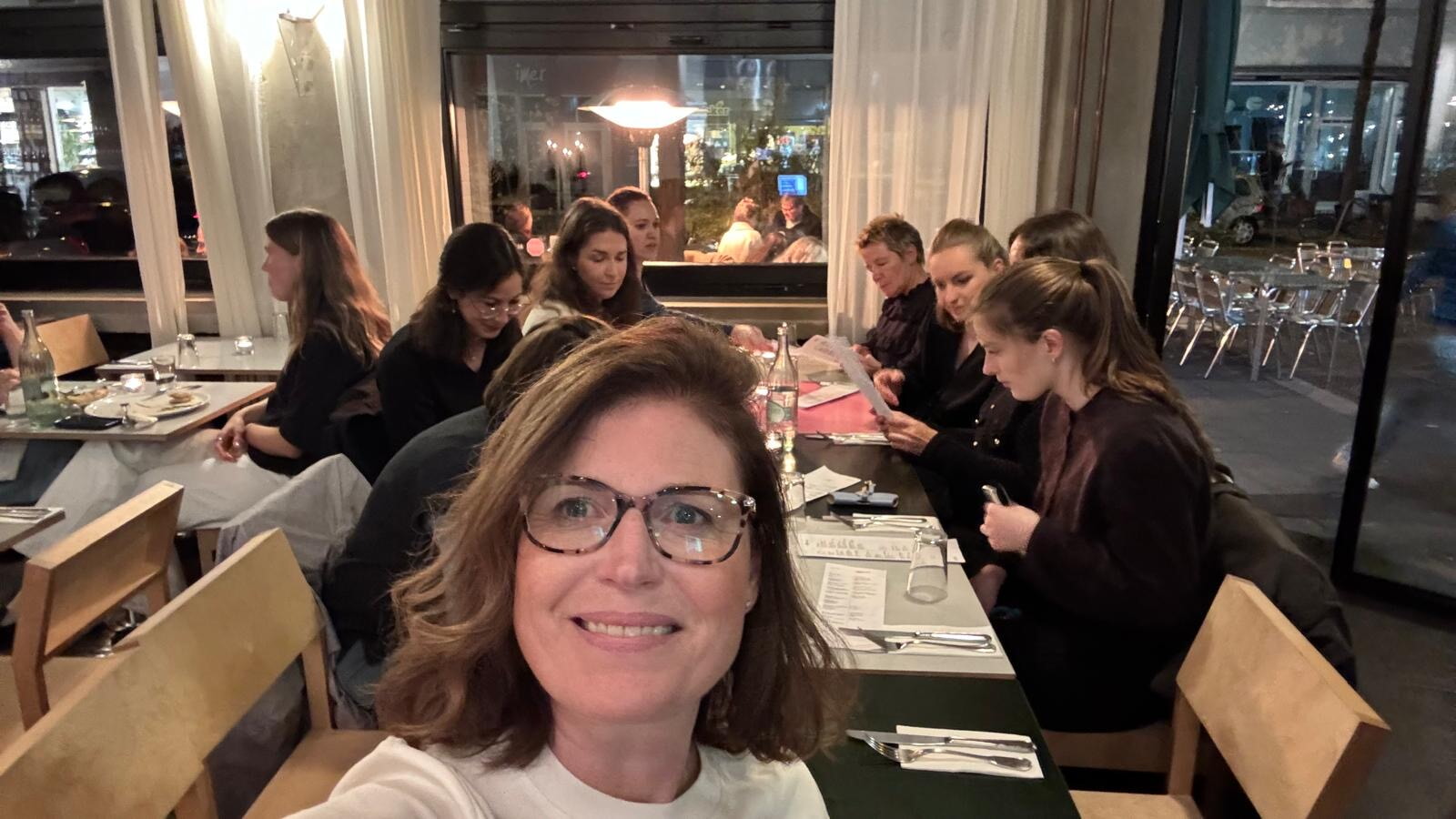Interview on Women at Work - Nevena Buzek
Our team member Constance Tournier recently interviewed Nevena Buzek, leadership coach, about the challenges women face in leadership and how to overcome them.
Date: 17. March 2025
Author: Constance Tournier
Categories: PGmeet, Female Leadership, Future Skills, Leadership

Can you share more about your background and the work you do?
My name is Nevena Buzek, and I have a master’s degree in education. Right after completing my master’s, I started working at Johnson Controls, which gave me my first experience in a multinational company. Since then, I have spent several years working in multinational corporations, always in roles related to training, people development, and leadership development.
Currently, I am a professional leadership and team coach with over eight years of experience in people development across multinational corporations, startups, and scale-ups in various industries. My expertise lies in coaching leaders and teams through change, fostering a modern leadership culture within organizations. I often refer to this as the “new era of leadership” because I see a strong need for a leadership approach that balances performance with psychological safety and people-oriented strategies.
A significant part of my work also focuses on empowering women in leadership, helping them navigate challenges that I have personally experienced. I am particularly passionate about guiding women through issues like imposter syndrome, unconscious bias, and executive presence. Many people associate leadership presence with being a leader, but I believe everyone should develop this quality.
I am deeply interested in psychology and how it can be applied to leadership. As a trained psychotherapy counselor in transactional analysis, I integrate psychological insights into my work to support organizations in building modern leadership cultures. I also love writing and frequently share my insights in newsletters, on social media, and at industry events to drive conversations about this new era of leadership.
I have also been using Hogan Assessments in leadership development and teamwork, and I have seen remarkable results through these tools.
In your experience coaching in workplaces today, what subtle forms of gender bias still persist?
Of course, workplaces have made huge progress. There’s a lot more awareness and conversation around these issues. However, unfortunately, gender bias still exists, and it’s something we need to continue addressing and working on.
One of the common challenges women face in leadership is the higher standard of likeability they are held to. I’ve often seen how assertive behavior—when displayed by men—is perceived as strong and positive, whereas the same behavior in women is frequently seen as aggressive. On the other side, many of the female clients I coach actively seek to develop assertiveness because they’re told they’re not assertive enough for a promotion. This creates a real contradiction—women risk negative evaluation for being assertive, yet also told they need to be more assertive. It’s a difficult balance to navigate in leadership.
Another bias I frequently observe is how women often have to prove and reprove their competence to be considered for promotions, whereas men are more commonly promoted based on their potential. They don’t necessarily have to prove their skills in the present, while women are continuously required to demonstrate their capabilities.
There’s also research to back this up. For example, McKinsey’s Women in the Workplace study from 2024 found that young women are twice as likely as young men to say their age draws unwanted attention at work. Women are also far more likely to experience comments and behaviors that undermine their skills and expertise. Social media is full of examples of this, with many women sharing their experiences of being mistaken for being more junior than they actually are—something that happens nearly twice as often to women as it does to men. When people see a young female executive, they often struggle to believe she holds that position.
And, of course, there’s the deeply ingrained bias around caregiving. There’s still an assumption that women with children are less committed to their careers. I’ve had clients who really struggled after returning from maternity leave, feeling as though they were being punished for taking time off to care for their children. Many of them feel pressured to return to work as soon as possible and then have to prove themselves all over again.
What advice would you give to women who struggle with guilt when prioritizing their careers?
I’ve seen many women struggle with this, unfortunately, in my work. We need to recognize that this guilt often comes from internalizing societal expectations—expectations that women should prioritize others over themselves and fulfill traditional social roles. This has been ingrained for ages, so when a woman tries to balance those expectations with her own ambitions, it can come as a shock to those around her.
My advice is to reframe career ambition as a form of self-leadership. When you invest in your growth and follow your passion, you set an example for those around you—your colleagues, your children, your family. There’s a saying, happy wife, happy life, but in this case, I’d say happy mom, happy life. If pursuing her passion makes a woman happy, her children would much rather have a happy, fulfilled mother at home than one who sacrifices her own dreams out of guilt.
It’s also important to remember that balance doesn’t mean giving equally to everything at all times. I don’t believe that’s realistic. Instead, balance comes from being intentional about our choices, setting boundaries without guilt, and recognizing that we can’t give 100% to everything simultaneously.
Another crucial, yet often overlooked, factor is infrastructure—surrounding yourself with a support system that reinforces your goals rather than making you feel guilty for pursuing them. Having a strong support network at home, in your personal life, and at work is essential. It’s just as important to build that system in the workplace—surrounding yourself with people who uplift and support you in achieving your goals.
Do you believe female leaders have distinct leadership styles compared to men? If so, how?
Do men and women lead differently? In some ways, yes—but not in a strictly consistent way. To be honest, I believe leadership style is shaped more by personality and environment than by gender. We bring our unique experiences and surroundings into how we lead rather than being defined solely by whether we are male or female.
Although, from my experience and research, I have noticed that many female leaders tend to embrace certain leadership qualities. They often adopt a highly collaborative and empathetic approach, practice transformational leadership, and prioritize inclusivity. They are excellent listeners and skilled at building deep, long-term relationships—qualities that are becoming increasingly valuable in today’s leadership environment. These are also key traits of the new era of leadership that I often talk about.
Finally, I don’t believe effective leadership is about having a male or female style. True leadership is about developing self-awareness and adapting to different situations—something that both men and women are equally capable of.
How does mentorship or coaching contribute to women’s professional growth?
Mentorship, Hogan Assessments, and coaching all play a huge role, and I’ve seen firsthand how powerful they can be. They provide women with the guidance, perspective, and confidence to navigate the systemic challenges we discussed earlier. A strong mentor, for example, can open doors, advocate for opportunities, and offer valuable insights on how to navigate workplace dynamics—essentially saying, I’ve been there, I’ve done that, here’s my advice.
Coaching, on the other hand, helps women build self-confidence and, when combined with assessments, provides a clear path for developing resilience and overcoming limiting beliefs that may be holding them back. Both mentorship and coaching are crucial in breaking down barriers to career success, offering the kind of support that is often missing in traditional leadership pipelines.
Beyond the workplace, I believe in the power of community. I love giving back and fostering networks where women can connect, learn, and grow together. In my work, I don’t just act as a coach—I actively introduce my clients to others, share my network, open doors, and ensure they are included in the community events I host. This, to me, is a perfect example of the infrastructure I mentioned earlier—building a strong support system that empowers women and helps them thrive.
Do you think people are becoming more aware of the importance of coaching?
Luckily, we’re seeing a big shift. More and more companies are investing in coaching—hiring coaches, integrating coaching into their culture, offering coaching workshops, one-on-one coaching, and team coaching. And they’re really recognizing the profound impact it has, which I’m incredibly happy about.
I believe coaching is valuable for all leaders, regardless of gender. While it benefits anyone facing workplace challenges, it can be especially transformative for women, who often navigate unique barriers like biases, imposter syndrome, and societal expectations. Coaching offers a space to build confidence, develop strategic thinking, and strengthen self-advocacy skills—empowering all leaders to thrive, while also addressing the distinct pressures women may encounter.
For example, I became a leader at 26 in a multinational corporation. I was young, working in a foreign country, the youngest in my department, and on top of that, a woman. All of these factors triggered my imposter syndrome. Fortunately, I had a coach at that time, and that experience showed me just how transformational coaching can be—especially for leaders navigating complex challenges.
That said, I wouldn’t say coaching is more essential for women. It’s just that the obstacles they face often make the benefits of coaching even more impactful.
Do you have an example of the challenges male leaders face in today’s workplace?
Absolutely! The new era of leadership emphasizes the human side of leaders—coaching skills, active listening, and emotional intelligence. However, many men, especially in certain cultures, are raised to believe that showing emotion is a sign of weakness. As a result, I’ve seen many male leaders struggle with these new leadership expectations.
In the past, leadership was often about being task-oriented, focusing on goals, KPIs, and performance. That was straightforward. But now, leadership involves emotions, and that’s not always easy to navigate. Many male leaders experience a sense of shock and uncertainty—What’s expected of me now? How do I adapt? Expectations have shifted, and both men and women are finding it challenging to adjust to this evolving leadership landscape.
How can women cultivate executive presence and establish themselves as influential leaders?
Establishing oneself as an influential leader today involves a combination of confidence, credibility, and connection. I always emphasize the importance of building a strong network and connection. Women, in particular, can start by owning their expertise. I’ve seen many women downplay their accomplishments, which shouldn’t be the case. Speaking with authority and not diminishing your achievements is key.
Commanding the room is also crucial—this includes using body language and voice projection. How you speak, how you position your hands, how you make eye contact—all these things matter. Providing a clear message is essential, as is strategic visibility. I work a lot with my female clients on this—encouraging them to speak up in meetings when they have something valuable to say. Taking on high-impact projects is another great way to demonstrate your capabilities and build credibility.
Networking is also vital. I always say, your network is your net worth. It’s so important to build and maintain meaningful relationships. Managing emotional intelligence is another key element, balancing warmth with assertiveness so you are perceived as approachable yet strong, with a solid leadership presence.
Something we haven’t touched on yet but is equally important is dressing with intention. Our clothing is part of our leadership brand—how we present ourselves visually. Aligning personal style with leadership presence is crucial to projecting confidence. Building your identity as a leader is also about aligning your actions and behaviors with that identity. Authenticity builds trust, and when people trust you, it’s an essential part of your executive presence.
I’ll never forget a story I want to share. In September, I gave a keynote speech at EY to 200 people. As I was preparing, my husband suggested I wear a black suit to look more serious. I told him, No, I want to be authentic. I didn’t need a black suit to command respect or trust. I chose to wear a purple suit because that’s my authentic self, and I knew I would still earn people’s trust. This story highlights the importance of not conforming to the stereotype that only women in black suits are credible. Instead, it’s about staying true to who you are while developing the skills and behaviors that help you succeed.
Get in touch to learn how Hogan can support your success!



